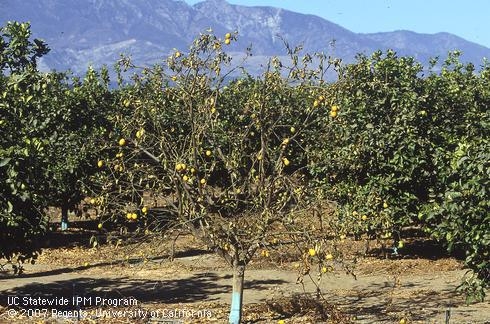Dry root rot has been a problem in citrus orchards for many years. Although generally a problem in coastal and northern California counties it has been reported in other citrus producing areas of the state. When present it generally occurs as a chronic problem affecting only a few trees in the orchard. Trees may be invaded at any time from planting to maturity; frequently mature, good producing trees are invaded. Once infection has occurred, it may be several years before any symptoms are visible in above-ground portions of the tree. Symptoms may be a gradual leaf drop and twig dieback or a sudden death of leaves which dry and remain in place. The tree rapidly collapses as a critical mass of roots is damaged or the crown area is girdled. Investigations of declining trees in the past revealed decaying bark in the root system and/or crown area of the tree which was thought to involve brown rot gummosis caused by Phytophthora invasion. The decaying bark area eventually dried and cracked. No gumming was observed, however, as is typical of brown rot gummosis. A grey staining of the woody portion of root or crown tissue was observed which is not seen with Phytophthora where only the cambium tissue is affected. Further investigations by researchers revealed that in affected tissue in these declining trees Fusarium solani could be isolated. Other organisms including bacteria and weak parasites and saprophytes could be isolated as well. Tissue samples from affected trees have consistently yielded Fusarium spp. Microscopic examination of affected areas revealed a plugging of the water conducting xylem tissue. During high temperatures, this plugging could result in slight wilt or rapid collapse of the tree depending upon the percentage of water conducting elements affected in the roots or crown area. Early investigations in declining orchards identified stress factors which seem to predispose the tree to invasion by the organism which is not possible without one or more of these agents. Stress factors identified included environmental factors such as drought, cultural such as damage from fertilizer, herbicide, nematicide or waterlogging, and damage from rodents such as gophers. Chemical agents applied at critical periods or in excessive amounts appeared to be stressful to affected tissue thus rendering it susceptible to invasion. Water ponding next to the trunk of the tree or waterlogging of the roots was associated with invasion of root or crown tissue and later colonization by this wood rotting organism. Stress produced in the tree together with the presence of the dry root rot organism is thought to predispose the tree to invasion of the organism. Research involving the mechanisms of invasion of Fusarium involved exposure of seedlings to hot water and then the dry root rot organism which resulted in invasion where exposure to the organism without previous exposure to high temperature did not result in invasion. It was hypothesized that high temperatures may have interfered with natural defense mechanisms allowing invasion. Research has identified a relationship between Phytophthora and the vascular wilt causing Fusarium spp. Phytophthora lesions on roots favored the invasion of the Fusarium. Seedlings exposed to only the wilt causing organism were not invaded, but were invaded if exposed to Phytophthora and then the wood rotting organism. A relationship was established between temperature and invasion of Phytophthora. Seedlings were not invaded by Phytophthora in a medium at 75 or 65 degrees but were at 55 degrees. Results suggested that the seedling formed scar/callus tissue capable of excluding the organism at higher temperature but was unable to do so at the lower temperature. While most commercial rootstocks possess a moderate to high degree of tolerance to Phytophthora invasion, all rootstocks are thought to be susceptible to the dry root rot organism.
Feb 15, 2013
